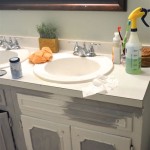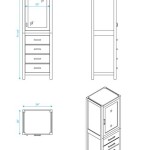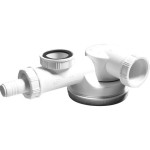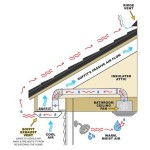Understanding the Lift Rod Pop-Up Bathroom Sink Drain
The lift rod pop-up bathroom sink drain is a common mechanism found in many residential and commercial bathrooms. It’s a system designed to control the flow of water in and out of the sink basin, offering a convenient alternative to simple open and closed drain stoppers. This article provides a comprehensive overview of the lift rod pop-up drain, detailing its components, functionality, installation, maintenance, and potential troubleshooting issues.
The primary advantage of the lift rod mechanism lies in its ability to control the drain stopper without requiring the user to reach directly into the sink. This is particularly beneficial for hygiene, as it minimizes contact with potentially contaminated water and debris. It also offers a more aesthetically pleasing solution, as the operating mechanism is typically integrated into the faucet fixture itself, providing a clean and streamlined appearance.
The design has evolved over time, with variations in materials and construction to improve durability and performance. However, the core principles of operation remain consistent. Understanding these principles is crucial for proper installation, maintenance, and troubleshooting when issues arise.
Key Components of a Lift Rod Pop-Up Drain
The lift rod pop-up drain assembly consists of several key components, each playing a crucial role in the system's overall functionality. A thorough understanding of these components is essential for diagnosing problems and performing repairs.
Lift Rod: The lift rod is a vertical metal rod, typically located behind the faucet. It’s the primary actuator for the drain system. When the lift rod is raised or lowered, it initiates the chain reaction that opens or closes the drain stopper.
Pivot Rod: The pivot rod is a horizontal rod that connects the lift rod mechanism to the drain stopper. It’s typically made of metal and features a ball joint that allows for smooth rotational movement. The pivot rod is a critical component for converting the vertical motion of the lift rod into the horizontal motion required to manipulate the drain stopper.
Drain Stopper: The drain stopper is the component that physically blocks the drain opening, preventing water from escaping the sink. It's typically made of metal with a rubber or silicone gasket around the edge to create a watertight seal. There are two primary types of drain stoppers used in lift rod systems: the pop-up stopper and the ball rod stopper. The pop-up stopper raises and lowers vertically, while the ball rod stopper pivots to seal the drain opening.
Clevis Strap: The clevis strap connects the lift rod to the pivot rod. It’s a small metal strap with multiple holes that allow for adjustments to the length of the connection. This adjustment is crucial for fine-tuning the responsiveness of the drain mechanism.
Drain Body: The drain body is the main housing of the drain assembly. It's the part that screws into the sink basin and connects to the drain pipe. The drain body provides the structural support for the entire drain system and contains the internal mechanisms that control the stopper.
Tailpiece: The tailpiece is a pipe that extends downward from the drain body and connects to the P-trap. It carries wastewater away from the sink and into the plumbing system.
Functionality and Operation
The operation of a lift rod pop-up drain is based on a simple mechanical principle: converting vertical motion into horizontal motion to manipulate the drain stopper. When the lift rod is raised, it pulls upward on the clevis strap, which in turn rotates the pivot rod. The rotation of the pivot rod either raises or lowers the drain stopper, depending on the design of the system. When the lift rod is lowered, the process is reversed, causing the stopper to close the drain.
The effectiveness of the system relies on the accurate alignment and adjustment of all the components. The length of the clevis strap, the position of the pivot rod, and the condition of the drain stopper all contribute to the overall performance of the drain. If any of these elements are misaligned or damaged, the drain may not function properly, leading to leaks or a failure to seal the drain opening completely.
The smoothness of operation is also dependent on lubrication. Over time, the pivot rod and ball joint can become stiff due to mineral buildup or corrosion. Applying a small amount of silicone grease to these components can help to restore smooth operation.
Variations in design exist, particularly in the type of stopper used. Some systems use a simple pop-up stopper that moves vertically, while others use a ball rod stopper that pivots to seal the drain. The ball rod stopper is often considered more reliable as it is less prone to getting stuck or misaligned, but both types are common.
Installation and Maintenance Procedures
Proper installation is critical for the long-term performance of a lift rod pop-up drain. The following steps outline the general installation procedure, but it's always recommended to consult the manufacturer's instructions for specific models.
Preparation: Before beginning installation, ensure that the water supply to the sink is shut off. Gather all necessary tools, including a pipe wrench, adjustable wrench, plumber's putty, and a screwdriver. Also, have a bucket and rags handy to catch any water that may be present in the drain lines.
Removal of Old Drain: If replacing an existing drain, carefully remove the old assembly. Disconnect the P-trap and tailpiece, then unscrew the drain body from the sink basin. Clean the sink basin thoroughly to remove any old plumber's putty or debris.
Installation of New Drain Body: Apply a generous amount of plumber's putty to the underside of the drain flange (the part that sits inside the sink basin). Insert the drain body into the sink basin, ensuring that the putty creates a watertight seal. From underneath the sink, attach the mounting hardware, including the rubber gasket, friction ring, and mounting nut. Tighten the mounting nut securely, but avoid over-tightening, which could crack the sink basin.
Connection of Pivot Rod and Lift Rod: Insert the pivot rod through the drain body and connect it to the drain stopper. Ensure that the stopper is properly aligned with the drain opening. Connect the lift rod to the clevis strap and adjust the strap to achieve the desired range of motion for the stopper. The goal is to have the stopper seal the drain completely when the lift rod is in the down position and to open the drain fully when the lift rod is in the up position.
Connection of Tailpiece and P-trap: Attach the tailpiece to the drain body and the P-trap to the tailpiece. Tighten all connections securely to prevent leaks. Turn the water supply back on and check for leaks around all connections. If any leaks are detected, tighten the connections further or reapply plumber's putty as needed.
Maintenance: Regular maintenance is essential for preventing problems. Periodically clean the drain stopper and pivot rod to remove hair and debris. A small brush or bent wire can be used to clear obstructions. Lubricate the pivot rod and ball joint with silicone grease to ensure smooth operation. Check all connections regularly for leaks and tighten as needed. A simple preventative maintenance routine can extend the life of the drain assembly and prevent costly repairs.
Troubleshooting Common Issues
Despite their relatively simple design, lift rod pop-up drains can experience a variety of problems. The following are some of the most common issues and their potential solutions.
Drain Stopper Not Sealing Properly: This is a common problem that can be caused by several factors. The most likely cause is an accumulation of hair and debris around the stopper or in the drain body. Clean the stopper and drain body thoroughly. Another possibility is that the clevis strap is not properly adjusted. Adjust the strap to ensure that the stopper seals the drain completely when the lift rod is in the down position. If the stopper is worn or damaged, it may need to be replaced.
Drain Stopper Not Opening Fully: This problem is often caused by a misadjusted clevis strap or a stiff pivot rod. Adjust the clevis strap to allow for full range of motion. Lubricate the pivot rod and ball joint with silicone grease to improve smoothness. If the drain body is clogged, it may restrict the movement of the stopper. Clean the drain body thoroughly.
Leaks Around the Drain Body: Leaks around the drain body are usually caused by a faulty seal between the drain flange and the sink basin. Tighten the mounting nut under the sink. If the leak persists, remove the drain body and reapply plumber's putty to the underside of the drain flange. Ensure that the putty creates a complete seal. Check the condition of the rubber gasket under the sink and replace if it is damaged.
Lift Rod Not Working: If the lift rod is not functioning, it could be disconnected from the clevis strap. Check the connection between the lift rod and the clevis strap and reattach if necessary. The lift rod itself may be bent or damaged, requiring replacement. In some cases, the issue may be with the internal mechanism of the faucet, requiring repair or replacement of the faucet assembly.
Slow Drainage: Slow drainage can be caused by a partial blockage in the drain pipe. Remove the drain stopper and use a drain snake or plunger to clear the blockage. Avoid using harsh chemical drain cleaners, as they can damage the drain pipes and the metal components of the drain assembly. Check the P-trap for any accumulated debris and clean accordingly.

Pop Up Lift Turn Pull Out Stopper Bathroom Sink Drains

Wowow Bathroom Sink Drain With Lift Rod Overflow Chrome Pop Up For Vessel Com

Wowow Bathroom Sink Drain With Lift Rod Overflow Chrome Pop Up For Vessel Com

Pop Up Drain Rod Assembly With Overflow Bathroom Sink Are Sheng

My Pop Up Drain Is Not Draining Water

How Does A Sink Pop Up Mechanism Work

Wowow Bathroom Sink Drain With Lift Rod Overflow Chrome Pop Up For Vessel Com

Pf Waterworks Bathroom Pop Up Drain With Ball Rod Transpa Abs W O Overflow 1 6 2 Sink Hole Chrome Pf0729 Ch Tr No The Home Depot

Fixing Tricky Pop Up Drain Sink Stopper Mechanisms Efficient Plumber

Pf Waterworks Polished Brass Bathroom Sink Pop Up Drain In The Drains Stoppers Department At Com
Related Posts







